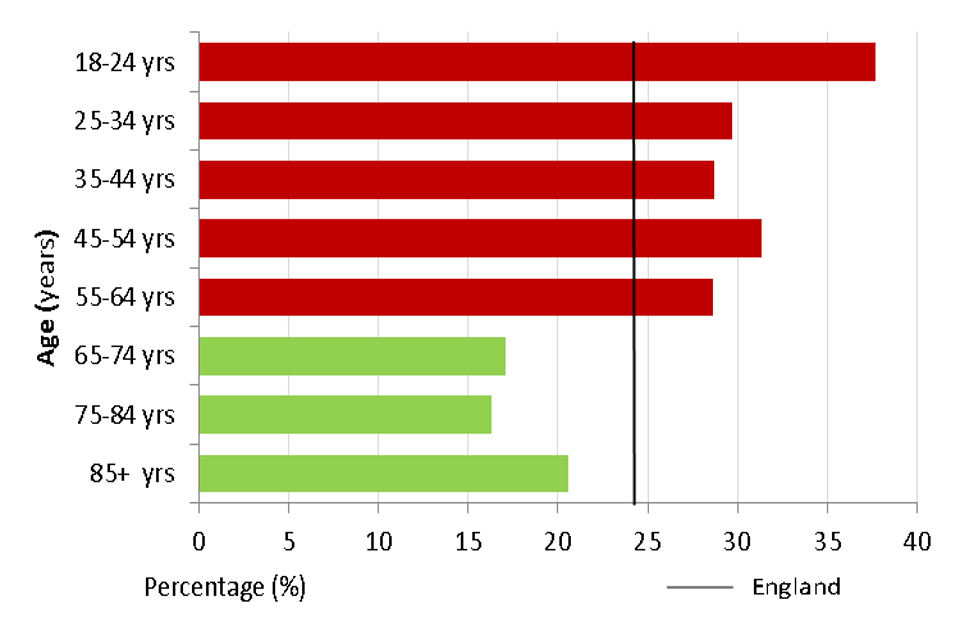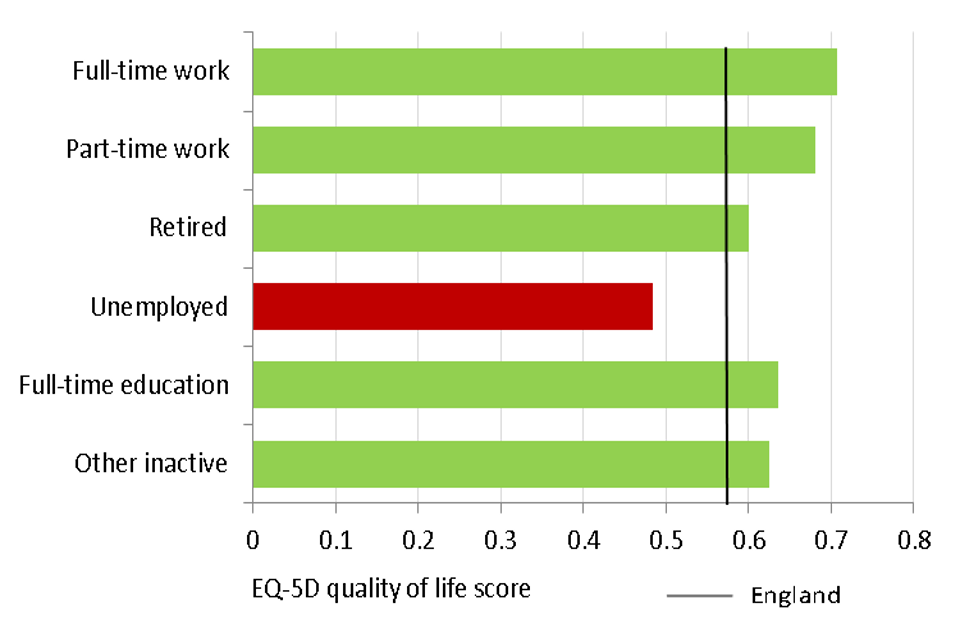Musculoskeletal diseases profile: short commentary, June 2018
Published 5 June 2018
New in this update
In this update 4 new indicators have been added to the musculoskeletal diseases profile and 4 indicators have been updated with new data points.
The following indicators are new to the profile:
- percentage reporting a long term musculoskeletal (MSK) problem
- percentage reporting depression or anxiety
- percentage reporting a long term MSK problem who also report depression or anxiety
- average health related quality of life score for adults who reported having a long term MSK problem
The following indicators have been updated with new data points:
- percentage reporting a long term back problem
- percentage reporting arthritis or a long term joint problem
- Rheumatoid arthritis: Quality and Outcomes Framework (QOF) prevalence (aged 16 and over)
- Osteoporosis: QOF prevalence (aged 50 and over)
Summary
Percentage reporting a long term MSK problem, GP Patient Survey, 2016 to 2017
In 2016 to 2017, 16.5% of people in England reported a long term MSK problem. This varied significantly between lower tier local authorities; Oxford had the lowest level at 10.1% and Hartlepool the highest at 24.6%.
Prevalence varied significantly by lower tier local authority deprivation decile group, with those in the least deprived decile reporting prevalence of 14.5% compared to those in the most deprived decile reporting 17.1%.
The percentage of people reporting a long term MSK problem significantly increased with age, with 3.4% of 18 to 24 years olds reporting an MSK problem compared with 42.0% in the 85 years and over category. Women reported a significantly higher prevalence of MSK problems than men (18.5% compared with 14.4%).
Percentage reporting a long term MSK problem who also reported depression or anxiety, GP Patient Survey, 2016 to 2017
The percentage of people reporting a long term MSK problem who also reported feeling anxious or depressed was 24.1% for 2016 to 2017. Prevalence varied significantly by age. Those in the younger age bands who had an MSK problem reported a significantly higher prevalence of depression or anxiety compared to those aged 65 years and over. In the 18 to 24 years age band 37.7% of those with an MSK problem reported feeling depressed or anxious, compared with 17.1% in the 65 to 74 years age band, 16.3% in the 75 to 84 years age band and 20.6% in the 85 years and over age band (Figure 1.)
Rates also varied significantly by lower tier local authority deprivation decile group, with those in the least deprived decile reporting rates of 17.0%, compared to 30.5% in the most deprived decile.
Figure 1: Percentage of those reporting a long term MSK problem who also report feeling depressed or anxious, by age, England, 2016 to 2017

Bar chart showing the percentage of people in England by age group reporting a long term musculoskeletal problem who also report feeling depressed or anxious in 2016 to 2017
Average health related quality of life score for adults who reported having a long term MSK problem, GP Patient Survey, 2016 to 2017
The average quality of life score, defined using the EQ-5D, for people who reported a long term MSK problem was 0.577, significantly worse than those without a long-term condition who had a score of 0.918[footnote 1] for 2016 to 2017.
Quality of life in those with an MSK problem varied by lower tier local authority, with Knowsley having the lowest score (0.448) and the Isles of Scilly the highest score (0.696). The indicator again varied significantly by deprivation decile, with those in the most deprived decile having the lowest score of 0.488, compared to those in the least deprived decile having a score of 0.622.
Working status affected quality of life in those with an MSK problem with those who classed themselves as unemployed having a significantly worse quality of life (0.484) compared to all other work categories (Figure 2).
Figure 2: Average health related quality of life score for adults who reported having a long term MSK problem, by work status, England, 2016 to 2017

Bar chart showing the average health related quality of life score for adults in England reporting a long term musculoskeletal problem by work status in 2016 to 2017
Background and further information
The musculoskeletal diseases profile aims to provide meaningful data, on a single platform, to enable the commissioning of high value musculoskeletal services. Musculoskeletal data is essential for understanding the health needs of local populations, the number of people accessing services, the cost of services and the outcomes services deliver.
Indicators should not generally be used in isolation but are best looked at in combination to produce an overall picture of the local situation. By using these in conjunction with other locally available data, organisations can undertake a ‘deep dive’ into areas of interest. This more structured approach should be used to uncover the deeper reasons underlying variation, identify opportunities for improvement and support the necessary work to deliver high-value services for people with musculoskeletal conditions.
Responsible statistician, product lead: Athena Chown
For queries relating to this publication, please contact: msk.enquiries@phe.gov.uk
-
PHE calculated from GP Patient Survey data, 2016/17. ↩
